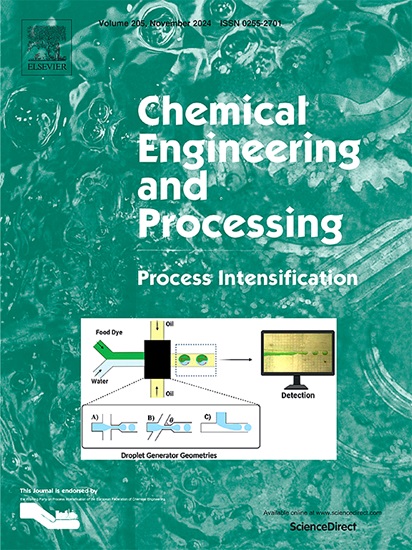AI-driven parametric optimization of gas-liquid absorption for the intensification of CO2 capture under a Gas-phase pulsation condition
IF 3.8
3区 工程技术
Q3 ENERGY & FUELS
Chemical Engineering and Processing - Process Intensification
Pub Date : 2025-01-25
DOI:10.1016/j.cep.2025.110183
引用次数: 0
Abstract
Traditional CO2 capture using amine-based solvents is effective but not an energy-intensive and requires frequent replenishment. This study explores enhancing CO2 absorption in packed bed columns by switching to sodium hydroxide and incorporating gas phase pulsation to improve mass transfer efficiency. Optimising a CO2![]() NaOH absorption process through its intensified volumetric mass transfer coefficient under a gas phase pulsation using artificial intelligence model is the main objective of this study. The mutual effects of pulsation amplitude, frequency, bed height, and solvent content on volumetric mass transfer coefficient was observed by Central Composite Design model of Response Surface Methodology where under an ideal frequency of 7.5 Hz, an amplitude of 18 mm, a bed height of 12 cm, and a solvent concentration of 2 N, the model attained a maximum volumetric mass transfer coefficient of 53.166 ± 0.55 s-1. This result was further validated through the Genetic Algorithm and Particle Swarm Optimisation models of Artificial Neural Networks. It revealed maximum coefficients of 54.52 ± 40 s-1 and 56.12 ± 60 s-1, respectively, with marginally differing ideal parameters. This study shows that artificial intelligence can substantially optimize CO2 capture processes by maximizing the volumetric mass transfer coefficient, leading to more efficient and cost-effective greenhouse gas reduction methods.
NaOH absorption process through its intensified volumetric mass transfer coefficient under a gas phase pulsation using artificial intelligence model is the main objective of this study. The mutual effects of pulsation amplitude, frequency, bed height, and solvent content on volumetric mass transfer coefficient was observed by Central Composite Design model of Response Surface Methodology where under an ideal frequency of 7.5 Hz, an amplitude of 18 mm, a bed height of 12 cm, and a solvent concentration of 2 N, the model attained a maximum volumetric mass transfer coefficient of 53.166 ± 0.55 s-1. This result was further validated through the Genetic Algorithm and Particle Swarm Optimisation models of Artificial Neural Networks. It revealed maximum coefficients of 54.52 ± 40 s-1 and 56.12 ± 60 s-1, respectively, with marginally differing ideal parameters. This study shows that artificial intelligence can substantially optimize CO2 capture processes by maximizing the volumetric mass transfer coefficient, leading to more efficient and cost-effective greenhouse gas reduction methods.

求助全文
约1分钟内获得全文
求助全文
来源期刊
CiteScore
7.80
自引率
9.30%
发文量
408
审稿时长
49 days
期刊介绍:
Chemical Engineering and Processing: Process Intensification is intended for practicing researchers in industry and academia, working in the field of Process Engineering and related to the subject of Process Intensification.Articles published in the Journal demonstrate how novel discoveries, developments and theories in the field of Process Engineering and in particular Process Intensification may be used for analysis and design of innovative equipment and processing methods with substantially improved sustainability, efficiency and environmental performance.

 求助内容:
求助内容: 应助结果提醒方式:
应助结果提醒方式:


